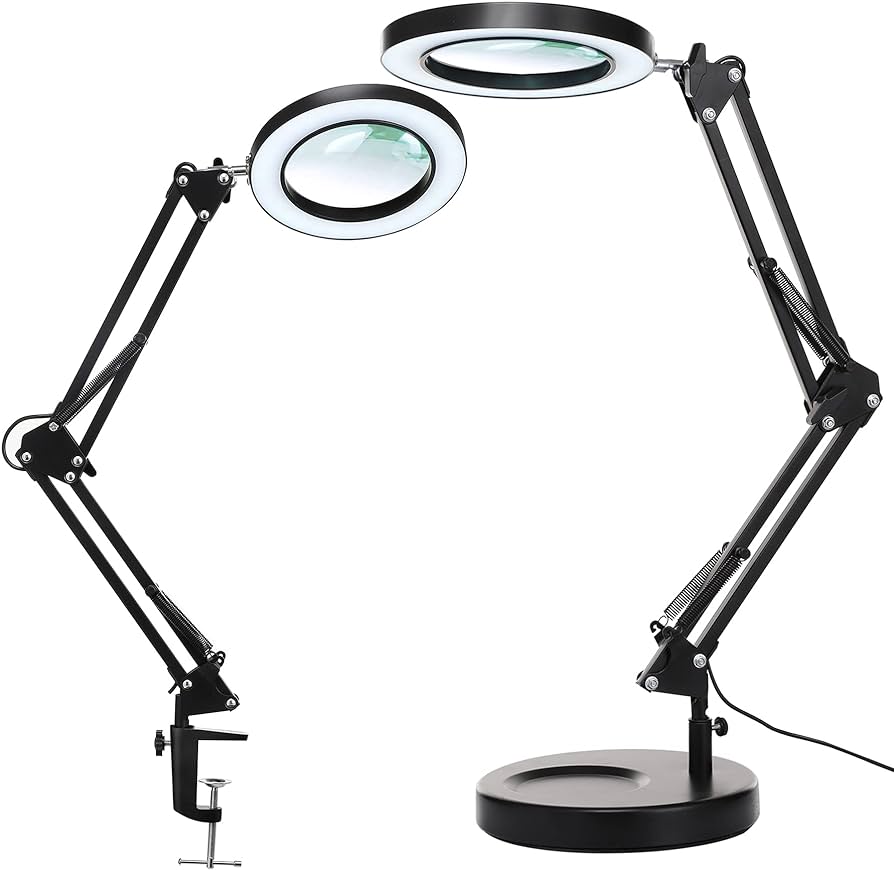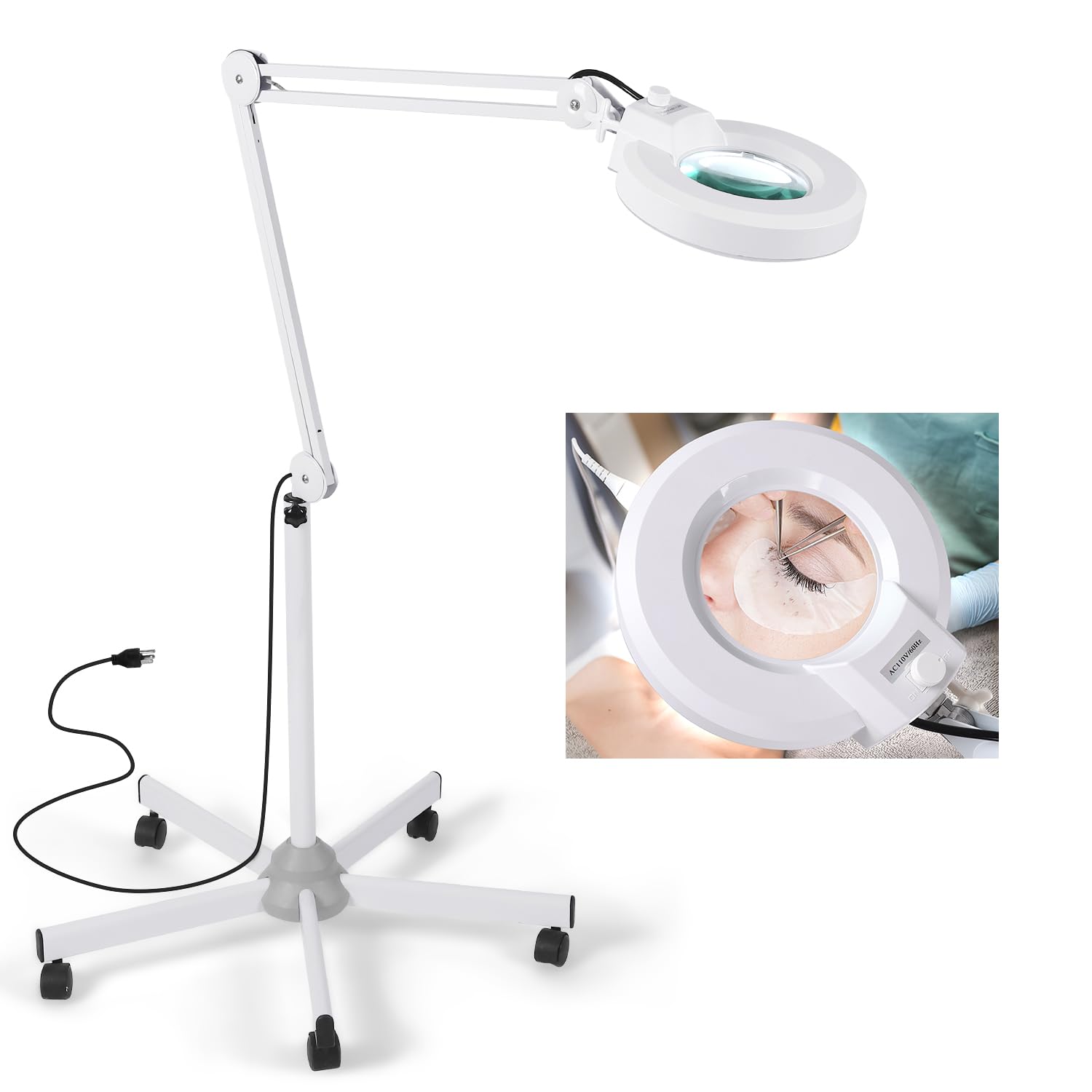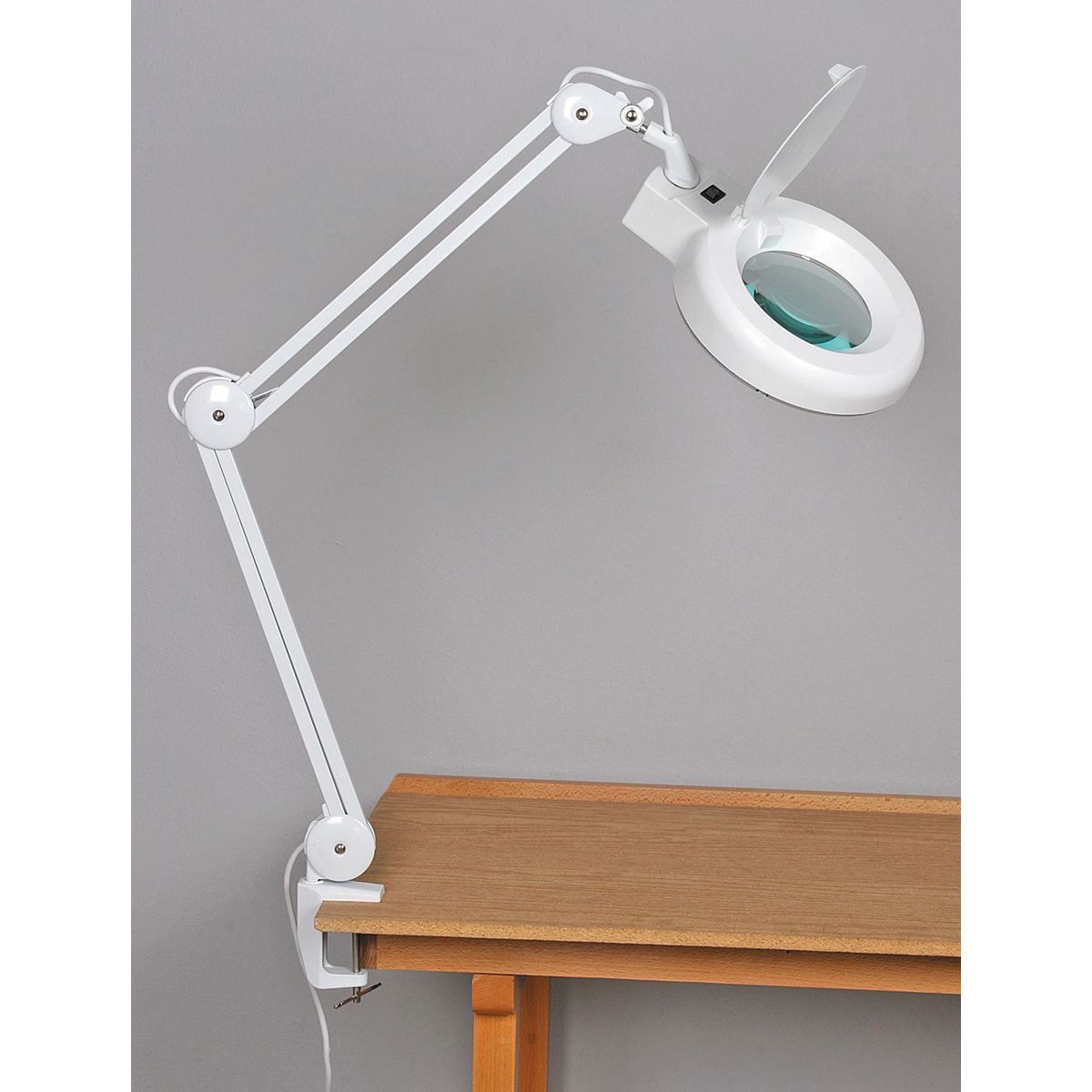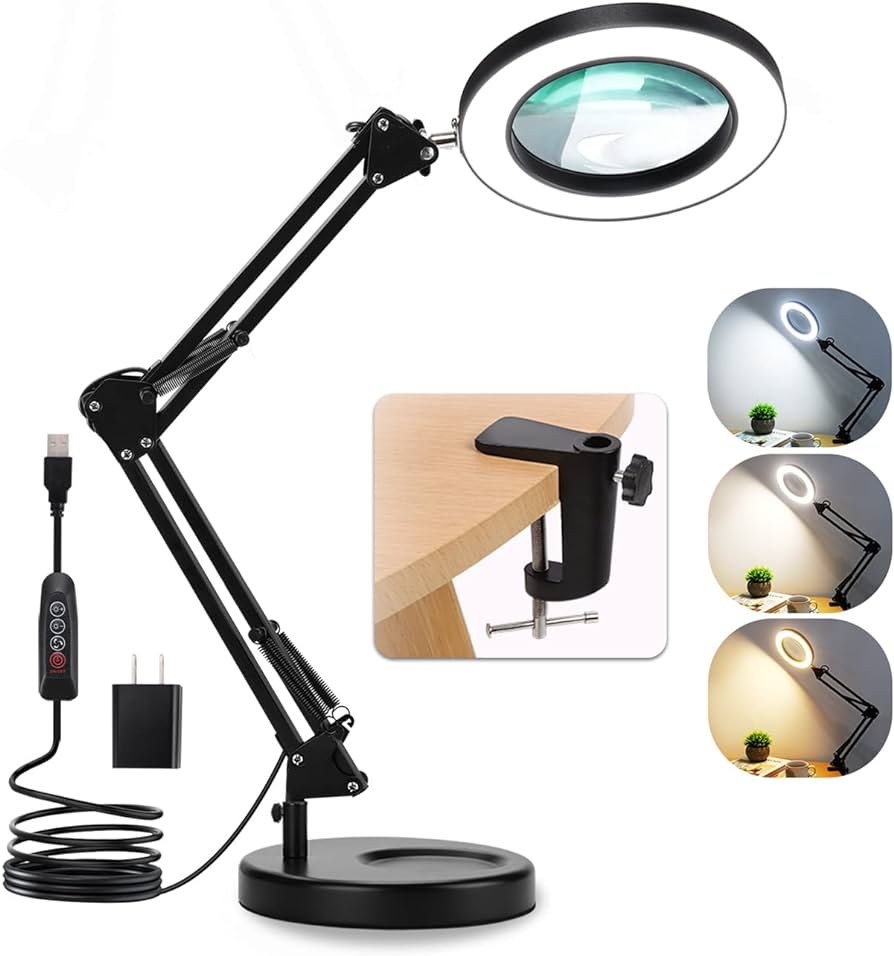Have you ever struggled to thread a needle, decipher tiny text, or examine intricate details? If so, a magnifying lamp with light might be the perfect solution for you. This ingenious tool combines a magnifying lens with a built-in light source, offering a helping hand whenever precise vision and clarity are paramount.

- Introduction to Magnifying Lamps: Enhancing Vision for Close-Up Tasks
Magnifying lamps are not simply powerful magnifying glasses on a stand. They are specially designed tools that illuminate the object being magnified, ensuring a well-lit and enlarged view for various tasks. These lamps find application in a wide range of fields, from enhancing hobbies and crafts to providing essential assistance in professional settings and even medical practices.
- Components of a Magnifying Lamp: Understanding Its Anatomy
A closer look reveals the key components that work together to make a magnifying lamp so effective:
* **The Magnifying Lens:** This is the heart of the lamp, responsible for enlarging the image. Lenses come in various strengths, measured in diopters (D). Lower diopters (e.g., 1x to 3x) provide moderate magnification, ideal for general tasks. Higher diopter lenses (e.g., 5x and above) offer significant magnification for extremely detailed work, but may have a smaller viewing area.
* **The Light Source:** Without proper illumination, magnification is rendered useless. Magnifying lamps typically use incandescent, fluorescent, or LED bulbs to bathe the magnified object in light. Incandescent bulbs provide a warm light, while fluorescent bulbs offer cooler tones and better energy efficiency. LED bulbs are quickly gaining popularity due to their energy efficiency, long lifespan, and ability to provide natural daylight-like illumination.
* **The Arm and Base:** These components provide the flexibility and stability needed to position the lamp for optimal use. The arm allows users to adjust the angle and height of the magnifying lens, directing it precisely towards the object of interest. The base ensures the lamp remains stable and prevents tipping over, especially when the arm is extended.
Types of Magnifying Lamps: Catering to Diverse Needs
The world of magnifying lamps is surprisingly diverse, offering a variety of options to suit different needs and preferences. Here’s a closer look at some of the most common types:
- Desktop Magnifying Lamps: A Versatile Option for Everyday Use
Desktop magnifying lamps are the workhorses of the magnifying lamp world. They are typically smaller and lighter than other types, designed for convenient placement on desks, workbenches, or tables. Their compact size makes them ideal for a variety of tasks, including:
* **Hobbies and Crafts:** Whether you're meticulously working on a miniature model, tying intricate fishing flies, or detailing a piece of jewelry, a desktop magnifying lamp provides the necessary magnification and illumination for precise work.
* **Reading Fine Print:** Small text in contracts, prescriptions, or beloved old books can become a strain on the eyes. A desktop magnifying lamp enlarges the text, making reading easier and more comfortable.
* **General Close-Up Work:** From examining stamps or coins to cleaning delicate electronics, a desktop magnifying lamp offers a magnified and well-lit view for various close-up tasks.
- Floor Magnifying Lamps: Hands-Free Magnification for Enhanced Comfort
Floor magnifying lamps offer a taller and sturdier alternative to desktop models. They are often equipped with a weighted base for added stability, making them ideal for situations where hands-free magnification is desired. Here are some scenarios where floor lamps shine:
* **Reading:** Floor lamps allow users to position the magnified view at a comfortable reading distance, eliminating the need to hunch over a desk. This can significantly improve posture and reduce neck strain during extended reading sessions.
* **Sewing and Quilting:** Threading needles, following intricate patterns, and ensuring precise stitching all become easier with the magnified view and hands-free convenience offered by a floor lamp.
* **Detailed Work:** Tasks like painting miniatures, sculpting small figures, or working on detailed artwork benefit from the magnified view and ample illumination provided by a floor lamp.
In addition to these two common types, there are also:
- Clip-On Magnifying Lamps: Compact and Portable for On-the-Go Magnification
These small and lightweight lamps attach to desks, tables, or other surfaces, offering a convenient magnification solution for travel or situations with limited space.
- Head-Mounted Magnifying Lamps: Hands-Free Magnification with Extreme Precision
Worn like a headset, these lamps provide a magnified view directly in front of the user’s eyes, ideal for tasks requiring exceptional precision and focus, such as jewelry repair, watchmaking, or intricate medical procedures.

Choosing the Right Magnifying Lamp: Factors to Consider
Now that you’ve explored the different types of magnifying lamps, it’s time to delve into the factors that will help you select the perfect one for your needs.
- Magnification Power (Diopters): Selecting the Appropriate Level of Enlargement
As mentioned earlier, the magnifying lens strength is measured in diopters (D). Here’s a breakdown to guide your choice:
* **1x to 2.5x:** Low magnification, suitable for general tasks like reading labels or inspecting small objects.
* **3x to 4x:** Moderate magnification, ideal for hobbies, crafts, and detailed reading.
* **5x and above:** High magnification, perfect for tasks requiring extreme precision, like watch repair or fine art restoration.
Remember, higher magnification provides a closer look but often comes with a smaller viewing area. Consider the size of the object you’ll be working with and the level of detail you need to see when choosing the diopter strength.
- Light Source: Ensuring Proper Illumination for Clear Vision
The type of light source can significantly impact your experience with a magnifying lamp. Let’s explore the pros and cons of each option:
* **Incandescent Bulbs:** Provide a warm, yellowish light, familiar and comfortable for many users. However, they are less energy-efficient and have a shorter lifespan compared to other options.
* **Fluorescent Bulbs:** Offer cooler, whiter light that some find more suitable for detailed tasks. They are generally more energy-efficient than incandescent bulbs and last longer. However, some fluorescent bulbs may flicker or emit a slight hum, which can be distracting for some users.
* **LED Bulbs:** The new standard for magnifying lamps, LEDs offer excellent energy efficiency, a long lifespan, and the ability to provide natural daylight-like illumination. This makes them ideal for tasks requiring accurate color perception, such as artwork or detailed inspection.
- Arm and Base: Flexibility and Stability for Optimal Positioning
A flexible arm allows you to adjust the angle and height of the magnifying lens for optimal viewing comfort. Look for an arm with a smooth range of motion and the ability to extend to the desired distance. The base should be sturdy enough to support the weight of the lamp and lens, especially for larger or heavier models. Consider weighted bases for added stability, particularly for floor lamps.
- Additional Features: Enhancing Functionality and Convenience
While not essential, some additional features can significantly enhance your experience with a magnifying lamp:
* **Dimmable Light:** Allows you to adjust the brightness level to suit different lighting conditions or tasks. This is especially helpful for situations requiring lower light levels, such as working with light-sensitive materials.
* **Color Correction:** Some lamps offer color-corrected light, mimicking natural daylight. This is beneficial for tasks requiring accurate color perception, such as artwork, graphic design, or some medical procedures.
* **Multiple Lenses:** Certain lamps come with interchangeable lenses with different diopter strengths, providing versatility for tasks requiring varying levels of magnification.
Using Your Magnifying Lamp Effectively: Tips for Optimal Results
Now that you have your perfect magnifying lamp, here are some tips to ensure you get the most out of it:
- Positioning the Lamp: Achieving Proper Lighting and Magnification
For optimal viewing, position the lamp so that the light source illuminates the object directly from above or slightly behind. This minimizes shadows and ensures a clear, well-lit magnified view. Adjust the distance between the lamp and the object to achieve the desired level of magnification and focus.
- Avoiding Glare:
Glare can cause discomfort and strain your eyes. Here’s how to minimize it:
* **Adjust the Angle:** Tilt the lamp head to avoid reflecting light directly onto your eyes.
* **Utilize Diffusers:** Some lamps come with diffusers attached to the light source, which help to soften the light and reduce glare.
* **Adjust the Environment:** If possible, dim the surrounding lights to create a contrast between the illuminated object and the background, further reducing glare.
- Taking Breaks:
Using a magnifying lamp for extended periods can cause eye strain. Take regular breaks to rest your eyes and avoid fatigue. Look away from the magnified object for a few minutes every 20-30 minutes, focusing on a distant object to refocus your eyes.
By following these tips and choosing the right magnifying lamp for your needs, you’ll unlock a world of enhanced vision and detail, making even the most intricate tasks a breeze.


